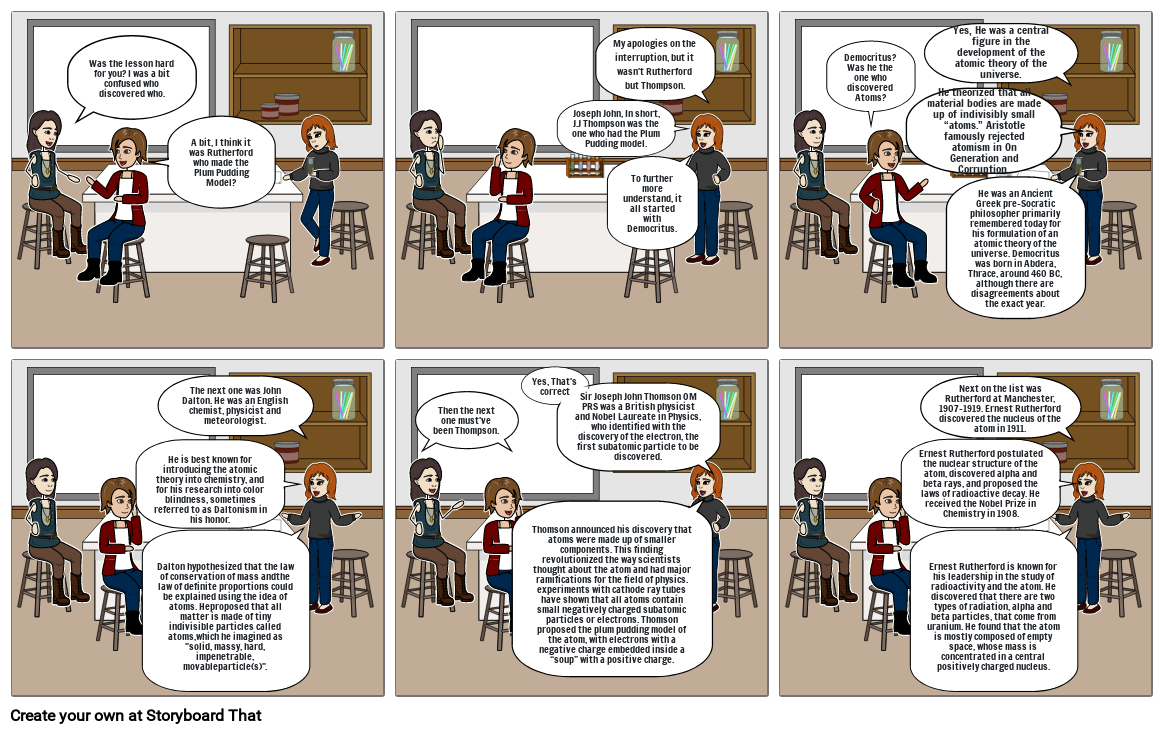6.1.1.2 Models of Atom Activity By Dilan

Storyboard Text
- Was the lesson hard for you? I was a bit confused who discovered who.
- A bit, I think it was Rutherford who made the Plum Pudding Model?
- My apologies on the interruption, but it wasn't Rutherford but Thompson.
- To further more understand, it all started with Democritus.
- Joseph John, In short, J.J Thompson was the one who had the Plum Pudding model.
- Democritus? Was he the one who discovered Atoms?
- Yes, He was a central figure in the development of the atomic theory of the universe.
- He was an Ancient Greek pre-Socratic philosopher primarily remembered today for his formulation of an atomic theory of the universe. Democritus was born in Abdera, Thrace, around 460 BC, although there are disagreements about the exact year.
- He theorized that all material bodies are made up of indivisibly small “atoms.” Aristotle famously rejected atomism in On Generation and Corruption.
- Dalton hypothesized that the law of conservation of mass andthe law of definite proportions could be explained using the idea of atoms. Heproposed that all matter is made of tiny indivisible particles called atoms,which he imagined as solid, massy, hard, impenetrable, movableparticle(s).
- The next one was John Dalton. He was an English chemist, physicist and meteorologist.
- He is best known for introducing the atomic theory into chemistry, and for his research into color blindness, sometimes referred to as Daltonism in his honor.
- Then the next one must've been Thompson.
- Thomson announced his discovery that atoms were made up of smaller components. This finding revolutionized the way scientists thought about the atom and had major ramifications for the field of physics. experiments with cathode ray tubes have shown that all atoms contain small negatively charged subatomic particles or electrons. Thomson proposed the plum pudding model of the atom, with electrons with a negative charge embedded inside a “soup” with a positive charge.
- Yes, That's correct
- Sir Joseph John Thomson OM PRS was a British physicist and Nobel Laureate in Physics, who identified with the discovery of the electron, the first subatomic particle to be discovered.
- Ernest Rutherford is known for his leadership in the study of radioactivity and the atom. He discovered that there are two types of radiation, alpha and beta particles, that come from uranium. He found that the atom is mostly composed of empty space, whose mass is concentrated in a central positively charged nucleus.
- Next on the list was Rutherford at Manchester, 1907–1919. Ernest Rutherford discovered the nucleus of the atom in 1911.
- Ernest Rutherford postulated the nuclear structure of the atom, discovered alpha and beta rays, and proposed the laws of radioactive decay. He received the Nobel Prize in Chemistry in 1908.
Over 30 Million Storyboards Created

